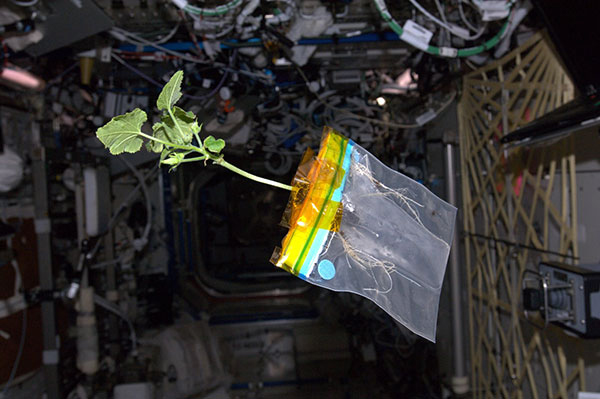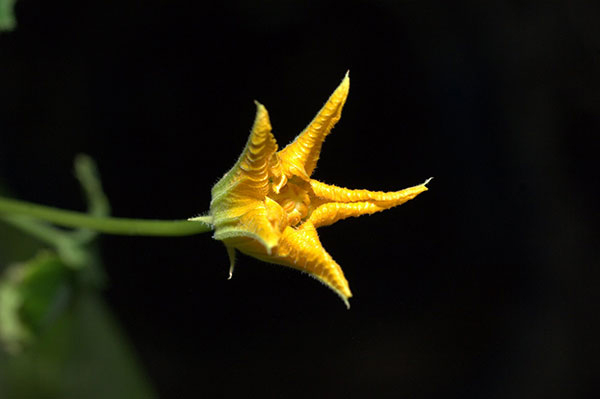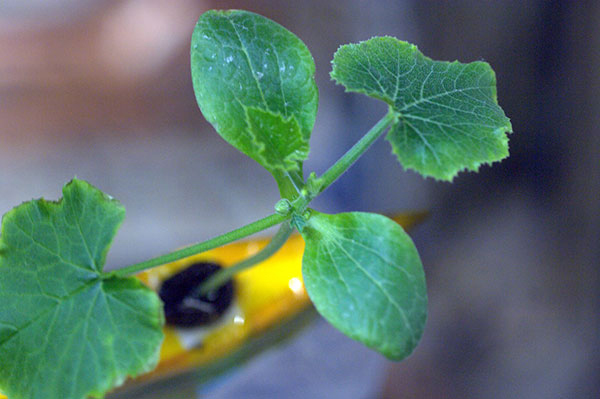Space Zucchini's Orbital Life and Times Blogged by Astronaut

Call it Zucchininaut. Or maybe Astrocchini.
A zucchini plant growing on the International Space Station is not only forging new scientific territory, but is winning the hearts of its human crewmates.
NASA astronaut Don Pettit, currently midway through a five-month stay on the orbiting laboratory, has taken a special shine to the space plant, and even writes blog posts in the voice of the zucchini.
"I became aware of my fellow crewmates for the first time," wrote Pettit as the zucchini on his blog Letters to Earth. "It takes a sprout a few days before grasping your surroundings. One is my gardener who waters my roots every day. I overheard that we are in a spacecraft orbiting Earth and are part of a long space mission. As crew, I am not sure of my role but am ready to contribute what I can."
Pettit is part of the six-man (and one-zucchini) crew of the space station's Expedition 30 mission, led by NASA astronaut commander Dan Burbank. The two Americans are joined by three Russian cosmonauts and a European Space Agency astronaut from the Netherlands.
In between their space station maintenance duties, all the astronauts devote significant time to science research in their weightless environment. One of Pettit's projects is watching how microgravity affects the growth of the zucchini. [Photos: Space Station Zucchini]
"I am becoming confused," wrote Pettit, as the plant. "These 16 short periods of day and night every 24 hours are making me jet-lagged. My photosynthesis activity just gets going and then abruptly shuts down. Repeating this cycle is putting me into a dither. My leaves do not sing as loud."
Get the Space.com Newsletter
Breaking space news, the latest updates on rocket launches, skywatching events and more!
The plant is housed in a Ziploc bag that retains moisture, and is fed a special nutrient concoction. It's being grown in a method called aeroponics that requires little soil or water.
"My gardener fusses with my leaves," wrote the plant, via Pettit. "I am not sure if I like that. I now have four and I do not quite understand why he behaves this way. He sticks his nose up against them. Does he take me for some sort of a handkerchief? Apparently he takes pleasure in my earthy green smell. There is nothing like the smell of living green in this forest of engineered machinery. I see the resultant smile. Maybe this is one of my roles as a crewmember on this expedition."
In addition to its science benefits, the zucchini brings a little more life to the small, sterile habitat in orbit.

After a while, the space zucchini wasn't alone as the only photosynthesis-based member of the space station's crew. Soon enough two other plant species were being grown alongside it.
"We have two new crewmates, Sunflower and Broccoli," Pettit-as-zucchini wrote. "Sunflower has a long stem for the size of his leaves. He is standing tall. Broccoli is small and weak. His sprout is so small that without the normal gravitational signals, surface tension forces keep his cotyledons from breaking free from the damp pigmat medium. Effectively, his first two leaves are glued down to a wet layer. Within a day or two mold takes over and the poor sprout dies. It grieves me to see them die. Life can be tough on the frontier."

Though Pettit has been diligently blogging as his green-leafed friend, he was surprised at the positive reaction his "Diary of a Space Zucchini" posts were getting. Someone even started a Twitter account, @Astro_Zuc, to speak for the orbital plant.
"Space zucchini is doing fine and I probably get the most benefit out of him or her or it, just because I'm the gardener, so the gardener has its privileges," Pettit said during a space-to-ground press conference Wednesday (April 11). "I am a little surprised. I fire off these little blogs and I don't get much feedback, so I'm surprised that other people seem to be following what's going on to my space zucchini. I understand that my space zucchini even has a Twitter account. It brings a smile to my face to see people are interested in such trimmings associated with the serious business of flying in space."
You can follow SPACE.com assistant managing editor Clara Moskowitz on Twitter @ClaraMoskowitz. Follow SPACE.com for the latest in space science and exploration news on Twitter @Spacedotcom and on Facebook.
Join our Space Forums to keep talking space on the latest missions, night sky and more! And if you have a news tip, correction or comment, let us know at: community@space.com.

Clara Moskowitz is a science and space writer who joined the Space.com team in 2008 and served as Assistant Managing Editor from 2011 to 2013. Clara has a bachelor's degree in astronomy and physics from Wesleyan University, and a graduate certificate in science writing from the University of California, Santa Cruz. She covers everything from astronomy to human spaceflight and once aced a NASTAR suborbital spaceflight training program for space missions. Clara is currently Associate Editor of Scientific American. To see her latest project is, follow Clara on Twitter.









